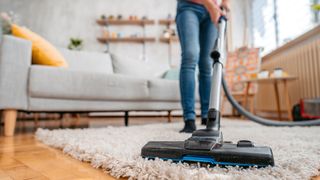Hours of research can go into picking the best vacuum cleaner (opens in new tab) for your home, but there’s no use scouring every model out there if your budget is very particular. Narrow things down by learning exactly which type of vacuum costs what, and streamline all of your options until you find your perfect vacuuming match.
Vacuum cleaner features to look for
Buying a cheap vacuum once will be enough to put you off for life, especially when it comes to the hassle of trying to clear dirt and debris from an unreliable unit. Instead, once you’ve decided on the particular type of vacuum you need (corded vs cordless, bagged vs bagless (opens in new tab)) then look for features that lend themselves to longevity above all else; well-engineered parts, a reputable manufacturer and retailer, and features that you’ll actually use. Models that cost more will usually have additional perks to make your life easier, including LED headlights, extra tools for your car or upholstery, or a HEPA filter for allergy sufferers.
How much should you spend on a vacuum cleaner?
Reserve at least $200 for a standard vacuum cleaner with quality parts. If your budget can’t stretch beyond that, then you’ll still be able to gain a good appliance that will last, as long as you keep on top of cleaning and maintenance. If you can afford it, then above the $200 mark you can start to benefit from the additional features mentioned above. Make a list of the features you know you will really get use out of and try not to get carried away with flashy benefits that you might see on higher-end vacs. Laurie Billson agrees, saying: “Vacuum cleaners do vary in price significantly so it can be tricky to know how much to spend on one, but generally you do get what you pay for. Equally, decide if you want a corded or cordless model and make sure it comes with attachments or can be set up in different ways to suit every cleaning need. If you have pets, consider a model with a floorhead designed specifically to pick up cat and dog hair. If you choose a cordless model, check the battery run time and whether it comes with a separate additional battery or if the battery is easily removable so that you can buy another battery to extend the run time. As we all look to reduce our carbon footprint, research models from brands with a commitment to sustainability as they will use quality parts that are designed and built to last. You don’t want to have to replace your vacuum cleaner within a few years of buying it."
Maintenance costs
Paying a specialist to look at your vacuum for you can cost up to $50 an hour, but visits to a hardware shop can be limited by regular cleaning and maintenance, such as learning how to replace a vacuum filter (opens in new tab) or clean a vacuum filter (opens in new tab). Be aware that bagged vacuums will incur extra costs due to the need to replace bags, whilst the filters on bagless models are more likely to feel strain over time and need to be replaced. Danielle Lessing, SVP, Global Product Development at SharkNinja (opens in new tab), explains further: “To maintain the best performance over time, routine maintenance is recommended and varies by vacuum, but almost all vacuums require regular dust-bin emptying. For example, the dust bin of the Shark® WANDVAC® System should be emptied after each use, while self-emptying models such as the Shark® AI Ultra Robot Self-Empty XL only require emptying once a month as the robot vacuum can hold up to 60 days of dirt and debris. Additionally, most models require regular filter changing around once a month”. Discover more guides for the home… Best top load washers (opens in new tab) Best dishwashers (opens in new tab) Best dryers (opens in new tab) Best steam mops (opens in new tab) Best robot vacuums (opens in new tab)







